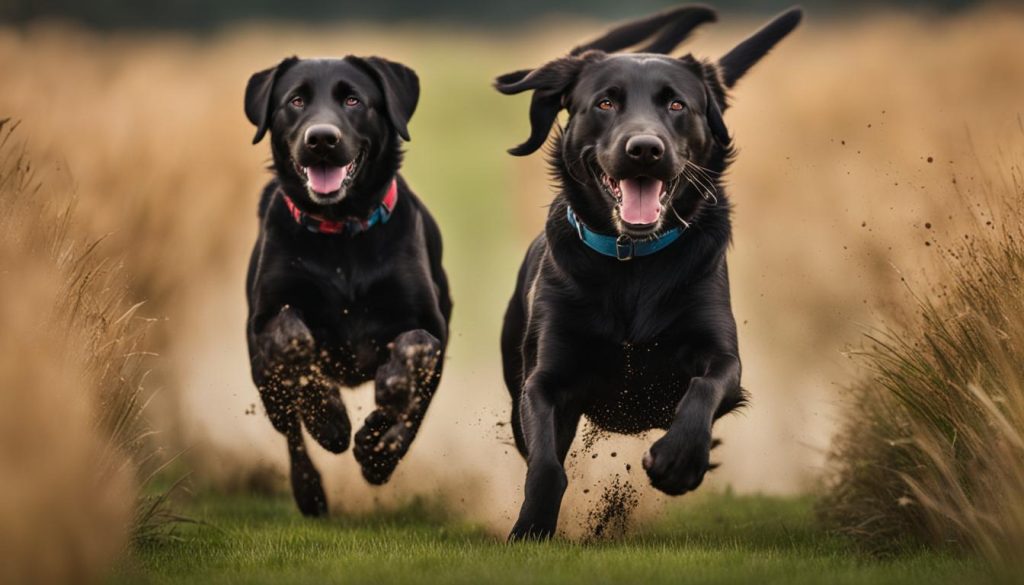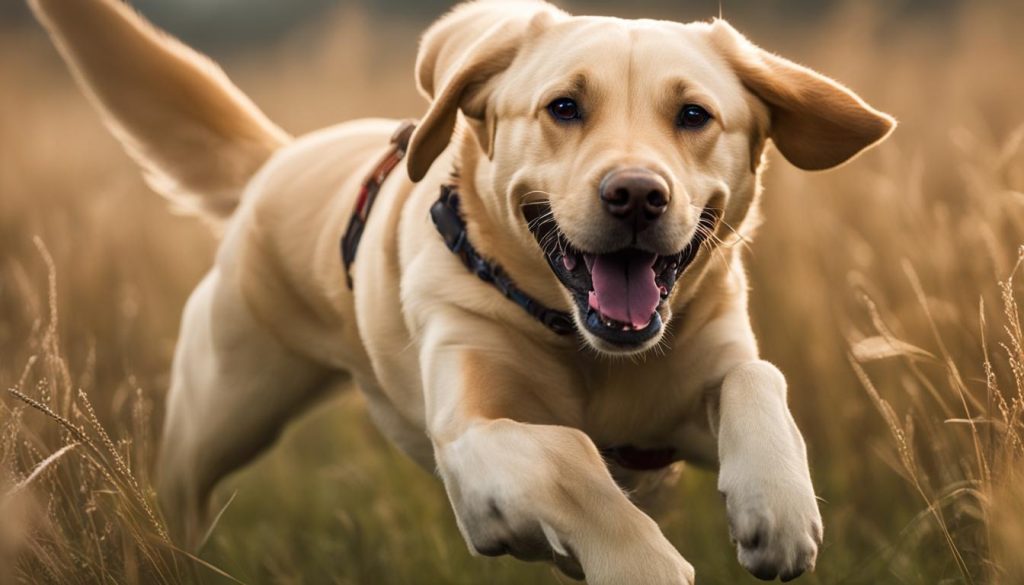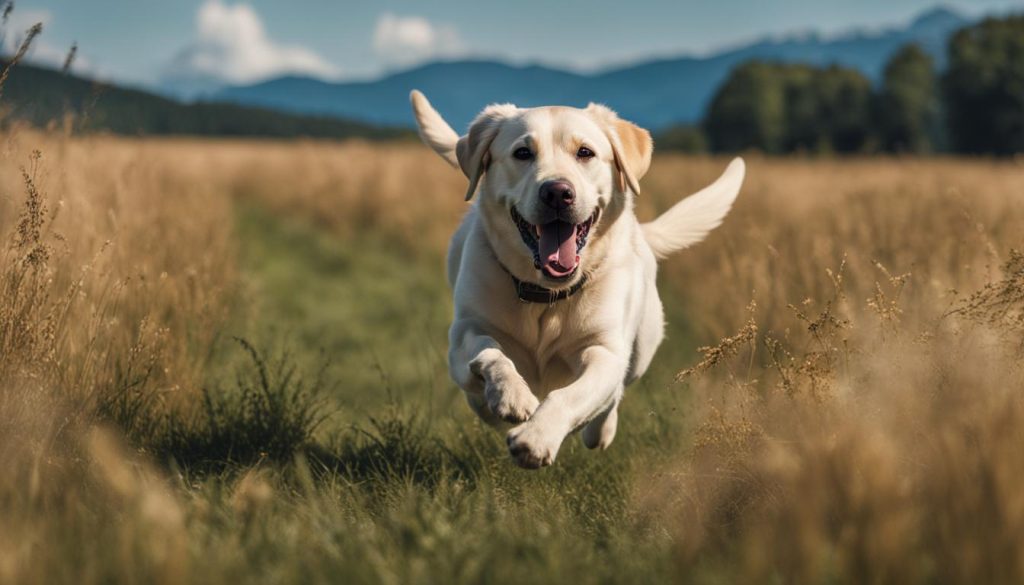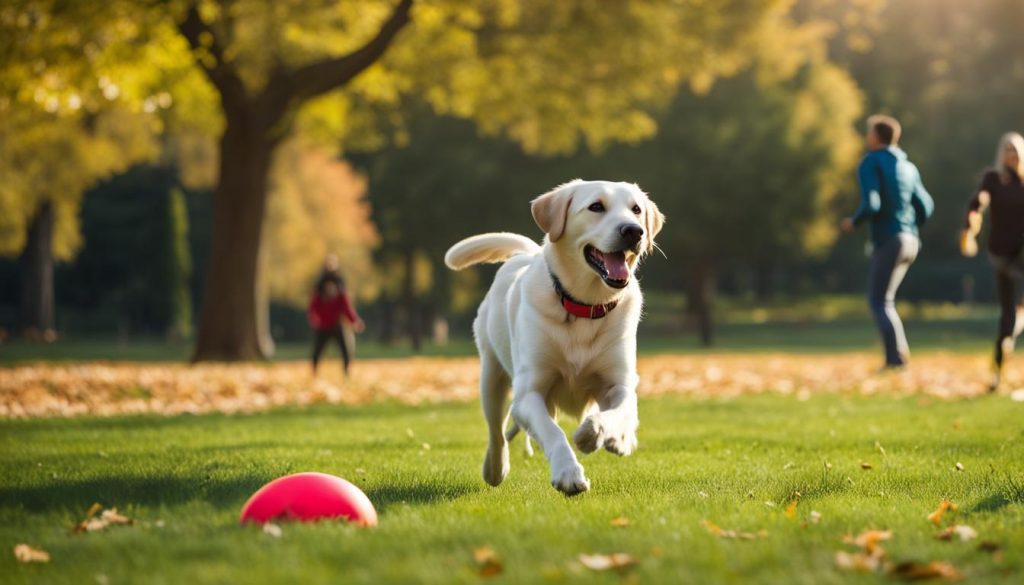Labrador Retrievers are beloved for their friendly and outgoing nature. These medium-sized dogs have a sturdy build and floppy ears, and they come in three main colors: black, yellow, and chocolate. Labs have an average energy level and require regular exercise to prevent destructive behavior.
Intelligent and easy to train, Labs make excellent working dogs and family pets. They are known for their loyalty and affection towards their families. While they are good with other pets and children, their energetic nature may be too much for young children at times. Labs have a thick, short double coat that sheds moderately and requires regular grooming.
In summary, Labrador Retrievers have a friendly, outgoing personality and are known for their intelligence and loyalty. They require regular exercise and grooming, making them a great choice for active individuals and families.
Key Takeaways:
- Labrador Retrievers have a friendly and outgoing nature.
- They are intelligent and easy to train.
- Regular exercise is important to prevent destructive behavior.
- Labs have a thick, short double coat that requires grooming.
- They are known for their loyalty and affection towards their families.
Labrador Retriever Attributes and Appearance

Labrador Retrievers have several distinct attributes and physical traits that contribute to their unique appearance. These characteristics make them instantly recognizable and beloved by many dog enthusiasts. Here, we will explore the various aspects of a Labrador’s appearance, including their size, weight, coat, and color.
Size and Weight
Labradors are medium-sized dogs with a sturdy and well-proportioned build. The maximum height for a male Labrador is typically around 24 inches, putting them in the medium-size category. In terms of weight, Labradors typically range from 55 to 80 pounds. Please be aware that individual Labradors may vary in size and weight, with some being slightly smaller or larger than the average range.
Coat and Color
One of the most notable features of a Labrador Retriever is their dense, short double coat. This coat serves as protection against various weather conditions and is known for its water-resistant properties. Labradors come in three primary colors: black, yellow, and chocolate. Each color can vary in shade, ranging from a rich dark hue to a lighter, more golden tone. The coat is typically solid in color, although some Labradors may have small white markings on their chest or toes.
Overall Appearance
Labradors have a square-shaped appearance with a strong body and sturdy legs. Their head is broad and carries a kind expression with friendly, expressive eyes. They have a well-defined stop and a strong muzzle that houses a set of powerful jaws. Labradors also have floppy ears that hang close to their head. Their tail is thick at the base and tapers towards the end, giving it a rudder-like appearance.
| Attribute | Description |
|---|---|
| Size | Medium-sized, with a maximum height of around 24 inches for males. |
| Weight | Ranges from 55 to 80 pounds, with individual variation. |
| Coat | Dense, short double coat that provides protection and is water-resistant. |
| Color | Comes in three main colors: black, yellow, and chocolate, with varying shades. |
| Overall Appearance | Square-shaped body, strong legs, broad head, floppy ears, and a rudder-like tail. |
Labrador Retriever Personality Traits

Labrador Retrievers are known for their exceptional personality traits, which contribute to their popularity as beloved family pets and working dogs. Understanding their temperament, behavior, and unique personality traits is essential for prospective Labrador owners.
Temperament
The Labrador Retriever has a friendly and outgoing temperament. They are highly sociable and get along well with other dogs, pets, and children. Labs are known for their patience and gentleness, making them an excellent choice for families. However, it is important to supervise interactions with young children due to their energetic nature.
Behavior
Labs have a strong desire to please their owners and are highly trainable. They are intelligent and quick learners, which makes training sessions enjoyable and rewarding. Labs require regular exercise to prevent boredom and destructive behavior. Their retrieving instinct is strong, so engaging them in games like fetch can help satisfy their natural instincts.
Labrador Retrievers are known for their friendly and outgoing nature, making them excellent family dogs.
Personality Traits
Labradors have several distinguishing personality traits that contribute to their popularity. They are loyal and affectionate towards their families, forming strong bonds. Labs are often described as “people-oriented” and enjoy being included in family activities. They have a protective nature and will go above and beyond to keep their loved ones safe. Labs are also renowned for their seemingly endless supply of love and enthusiasm, making them a joy to be around.
The table below provides a summary of Labrador Retriever personality traits:
| Personality Traits | Description |
|---|---|
| Friendly | Labradors are known for their friendly and outgoing nature. They get along well with other dogs, pets, and children. |
| Intelligent | Labs are highly intelligent and quick learners. They excel in obedience training and can easily pick up new commands. |
| Loyal | Labradors are fiercely loyal to their families. They form strong bonds and will always be by your side. |
| Protective | Labradors have a protective nature and will guard their loved ones. They make excellent watchdogs. |
| Enthusiastic | Labs are known for their enthusiasm and zest for life. They bring joy and energy to every moment. |
Understanding Labrador Retriever personality traits is crucial for anyone considering adding one to their family. These lovable dogs bring immense joy and companionship to their owners, making them an ideal choice for various lifestyles and households.
What to Expect from a Labrador Retriever

Labrador Retrievers are beloved for their friendly and outgoing personalities, intelligence, and loyalty. If you’re considering adding a Labrador to your family, it’s important to have a good understanding of what to expect from these amazing dogs. From their behavior to their exercise needs and overall care, here’s what you need to know about living with a Labrador Retriever.
Labrador Behavior
Labradors are known for their friendly and sociable nature. They are highly social dogs that enjoy the company of their families and are generally good with other pets and children. Labradors have a strong desire to please their owners, which makes them eager learners and easy to train. However, Labradors can have a lot of energy and can get bored easily if not given enough exercise and mental stimulation.
Labrador Exercise Needs
Labradors are active dogs that require regular exercise to stay happy and healthy. They thrive in environments where they have ample space to run and play. A Labrador should engage in at least 40 minutes of exercise per day, which can include activities such as walking, running, swimming, and playing fetch. Regular exercise not only keeps them physically fit but also helps prevent boredom and destructive behaviors.
Labrador Care
Proper care is essential to keep your Labrador healthy and thriving. In addition to regular exercise, Labradors require a balanced diet, grooming, and routine veterinary care. Labradors have a thick, short double coat that requires regular brushing to prevent matting and shedding. They may also need occasional baths to keep their coats clean. Regular veterinary check-ups, vaccinations, and parasite prevention are important to ensure their overall well-being.
Labrador Training
Training is crucial for Labradors to develop good manners and control their energy. They are intelligent and eager to please, making them highly trainable. Early and consistent training is essential to teach them basic obedience commands and ensure they are well-behaved around other dogs and people. Positive reinforcement techniques, such as rewards and praise, work best with Labradors. Training sessions should be kept short and fun to hold their attention.
In summary, Labrador Retrievers are friendly, energetic, and highly trainable dogs. They require regular exercise, proper care, and consistent training to thrive. If you’re prepared to provide them with a loving and active home, a Labrador Retriever can be a wonderful addition to your family.
The History of Labrador Retrievers

The history of Labrador Retrievers dates back to the 1800s in Newfoundland, Canada. These dogs were originally bred as working dogs to assist fishermen in retrieving fish and game. With their strong swimming abilities, webbed feet, and thick water-resistant coat, Labradors were well-suited for working in the harsh maritime climate. Their friendly and trainable nature also made them popular companions and helpers for hunters.
In the early 19th century, Labradors caught the attention of English sportsmen who visited Newfoundland. The English developed a keen interest in these dogs and brought them back to England. In England, Labradors were selectively bred for specific traits, refining their appearance and temperament. The breed gradually evolved into the Labrador Retriever we know today, with its distinctive attributes and friendly nature.
Labrador Retrievers gained recognition and popularity due to their versatility and excellent retrieving skills. They were utilized as working dogs in various fields, including hunting, tracking, and retrieving game. Their intelligence and adaptability also made them valuable in search and rescue operations, as well as serving as therapy and assistance dogs. Today, Labradors are one of the most popular dog breeds in America and around the world.
The Origins of Labrador Retrievers
The Labrador Retriever has its origins in the coastal region of Newfoundland, Canada, where they were bred by fishermen to assist in retrieving fish and game. Their exceptional swimming abilities and robust build made them well-suited for their original working purpose.
Labrador Breed Development
| Timeline | Milestone |
|---|---|
| 1800s | Labrador Retrievers were developed as working dogs in Newfoundland, Canada. |
| 19th Century | English sportsmen brought Labradors to England, where breed refinement and development took place. |
| 20th Century | Labradors gained popularity as versatile working dogs, excelling in hunting, search and rescue, and assistance roles. |
| Present | Labradors are recognized as one of the most popular dog breeds worldwide, known for their friendly nature and versatility. |
Labrador Retriever Exercise and Activity Needs

Labrador Retrievers are highly active dogs that require regular exercise to stay happy and healthy. They have an average energy level and should engage in at least 40 minutes of exercise per day. Labs enjoy activities such as walking, running, swimming, and playing fetch. They thrive in environments where they have ample space to move around and explore. Labs also enjoy mental stimulation through training sessions and interactive toys. Regular exercise helps prevent boredom and destructive behaviors in Labs.
Labrador Retrievers have a natural retrieving instinct, making activities such as fetch a great way to exercise both their bodies and minds. These dogs are also excellent swimmers, so a trip to the beach or a nearby lake can provide them with a fun and refreshing workout. Please be aware that Labs love to explore and can be prone to wander if left unleashed in open spaces, so it’s essential to ensure they are in a secure environment when engaging in outdoor activities.
Aside from physical exercise, Labs also require mental stimulation to keep their intelligent minds engaged. Training sessions that incorporate obedience training, tricks, and problem-solving exercises can help fulfill their mental needs. Interactive toys that challenge their problem-solving skills, such as puzzle toys or treat-dispensing toys, can also be beneficial.
Exercise Guidelines for Labrador Retrievers
- Provide at least 40 minutes of exercise per day.
- Engage in activities such as walking, running, swimming, and playing fetch.
- Ensure they have ample space to move around and explore.
- Incorporate mental stimulation through training sessions and interactive toys.
- Supervise outdoor activities to prevent wandering.
Table: Recommended Exercise Activities for Labrador Retrievers
| Activity | Duration | Benefits |
|---|---|---|
| Walking | 30 minutes to 1 hour | Low-impact exercise that helps maintain overall fitness |
| Running or Jogging | 30 minutes to 1 hour | Provides cardiovascular exercise and burns excess energy |
| Swimming | 20 minutes to 1 hour | Low-impact exercise that is easy on the joints and helps cool down Labs in hot weather |
| Playing Fetch | 15-30 minutes | Stimulates the retrieving instinct and provides mental and physical exercise |
Labrador Retriever Grooming and Care

Grooming and care are essential aspects of keeping your Labrador Retriever healthy and looking their best. Regular maintenance of their coat, ears, teeth, and overall well-being will ensure your Lab remains happy and comfortable. Here are some important tips and guidelines to follow:
Grooming Needs
The Labrador Retriever has a short, dense double coat that requires regular brushing to remove loose hair and prevent matting. This breed tends to shed moderately throughout the year, with heavier shedding periods during seasonal changes. To manage the shedding, regular brushing with a slicker brush or a deshedding tool is recommended. It helps to minimize loose hair around your home and maintain the coat’s overall condition. Additionally, Labs’ floppy ears should be checked and cleaned regularly to prevent infections caused by moisture and debris buildup.
Care Tips
Labradors require more than just grooming to stay healthy. Regular exercise is crucial as these dogs have an average energy level and need physical activity to prevent boredom and destructive behavior. Aim for at least 40 minutes of exercise per day, such as brisk walks, jogging, or playing fetch. Proper nutrition is also essential for your Lab’s well-being. Consult with your veterinarian to determine the appropriate diet and feeding schedule for your dog’s age, activity level, and specific dietary needs. Lastly, regular veterinary check-ups, vaccinations, and parasite prevention are important to maintain your Lab’s overall health and catch any potential issues early.
Skin and Coat Care
Proper care for your Lab’s skin and coat is crucial in ensuring their comfort and well-being. Regular brushing not only helps manage shedding but also stimulates blood flow and distributes natural oils, keeping the coat healthy and shiny. Bathing should be done as needed, using a gentle dog shampoo to avoid stripping away the coat’s natural oils. It’s important to dry your Lab thoroughly after bathing to prevent moisture from getting trapped in their dense coat, which can lead to skin problems. Additionally, regular checking of their skin for any abnormalities, such as rashes or dry patches, is recommended. If you notice any issues, consult your veterinarian for proper diagnosis and treatment.
| Grooming Considerations | Frequency |
|---|---|
| Brushing | 2-3 times per week |
| Bathing | As needed, typically every 6-8 weeks |
| Ears | Weekly cleaning |
| Nails | Monthly trimming |
| Teeth | Daily brushing |
Grooming and care are not only essential for your Labrador Retriever’s physical well-being but also play a significant role in maintaining a strong bond between you and your furry companion. Regular grooming sessions can be a pleasant and bonding experience for both of you. By following these tips and establishing a grooming routine, you can keep your Lab happy, healthy, and looking their best.
Labrador Retriever Health Considerations

When it comes to Labrador Retrievers, it’s important to be aware of certain health considerations. While Labs are generally healthy dogs, they can be prone to certain genetic conditions and health issues. By understanding these potential challenges, you can take proactive steps to ensure the wellbeing of your Labrador.
Labrador Genetic Conditions
Labrador Retrievers are known to be susceptible to certain genetic conditions. One of the most common is hip dysplasia, a condition that affects the hip joints, causing pain and mobility issues. Regular exercise and maintaining a healthy weight can help minimize the risk of hip dysplasia. It’s also important to choose a reputable breeder who conducts health screenings for their breeding dogs to reduce the likelihood of passing on this condition.
Eye Problems in Labradors
Labradors can also be prone to various eye problems, including progressive retinal atrophy (PRA), cataracts, and retinal dysplasia. PRA is a degenerative condition that ultimately leads to blindness. Regular eye examinations by a veterinarian can help detect these issues early on, allowing for proper management and treatment.
Providing Proper Care for Your Labrador
To ensure the overall health of your Labrador Retriever, it’s essential to provide them with proper care. Regular veterinary check-ups, vaccinations, and parasite prevention are crucial. Additionally, a balanced diet, regular exercise, and maintaining a healthy weight are important components of Labrador care. Paying attention to their dental health, grooming needs, and overall well-being will help your Labrador live a happy and healthy life.
Labradors as Family Dogs
Labrador Retrievers are well-known for their friendly and sociable nature, making them an excellent choice for families. They have a gentle and patient temperament, which makes them great companions for children. Labs are typically very tolerant and can handle the energetic nature of kids. However, it’s important to supervise interactions between young children and Labs due to their exuberance.
Labradors are also known for their loyalty and affection towards their families. They form strong bonds with their human companions and will often go above and beyond to protect and care for them. With proper training and socialization, Labs can coexist harmoniously with other pets in the household.
Labradors require plenty of exercise and mental stimulation, which makes them an ideal fit for active families. They love being involved in family activities and enjoy outdoor adventures like walks, hikes, and playtime in the yard. Labs thrive in an environment where they receive enough love, attention, and physical activity.
So, if you’re looking for a family-friendly dog that is loyal, affectionate, and great with kids, the Labrador Retriever may be the perfect addition to your household.
Labrador Retriever Training and Socialization
Training and socialization are crucial aspects of raising a Labrador Retriever. Proper training helps to ensure that your Lab is well-behaved and obedient, while socialization helps them to be comfortable and friendly around other dogs, pets, and people. Here are some key tips for training and socializing your Labrador:
Labrador Retriever Training Tips
- Start training early: Begin training your Labrador Retriever as soon as you bring them home. Puppies have a natural curiosity and are quick learners, so early training sets a solid foundation for their behavior.
- Use positive reinforcement: Labs respond well to positive reinforcement techniques such as treats, praise, and rewards. Use these rewards to reinforce desired behaviors and make the training experience enjoyable for your Lab.
- Be consistent: Consistency is key when training a Labrador. Use the same commands and signals consistently to avoid confusion and reinforce good behavior.
- Focus on basic commands: Teach your Lab essential commands such as sit, stay, come, and leash walking. These commands not only improve their obedience but also ensure their safety and your control in various situations.
Labrador Retriever Socialization Tips
- Start early and continue throughout their life: Begin socializing your Labrador from a young age and continue exposing them to new environments, people, and animals throughout their life. This helps them become well-adjusted and confident dogs.
- Expose them to various stimuli: Introduce your Lab to different sounds, sights, smells, and textures. This helps them become comfortable in various situations and reduces the likelihood of fear or anxiety.
- Arrange playdates and outings: Regularly set up playdates with other dogs or take your Lab to dog parks to interact with different breeds and sizes. This helps them develop appropriate social skills and manners with other dogs.
- Enroll in obedience classes: Obedience classes not only provide structured training but also offer opportunities for your Lab to socialize with other dogs and people in a controlled environment.
Remember that every Labrador Retriever is unique, and training and socialization should be tailored to their individual needs and personality. Be patient, consistent, and understanding throughout the process, and you’ll have a well-trained and well-socialized Labrador as a beloved companion.
| Training Tips | Socialization Tips |
|---|---|
| Start training early | Start early and continue throughout their life |
| Use positive reinforcement | Expose them to various stimuli |
| Be consistent | Arrange playdates and outings |
| Focus on basic commands | Enroll in obedience classes |
Labradors and Their Versatility
Labrador Retrievers are renowned for their exceptional versatility, excelling in various roles and activities. Their intelligence, trainability, and friendly nature make them the perfect candidates for a wide range of tasks and jobs. This section will explore the different areas where Labradors showcase their remarkable versatility.
Table: Roles and Activities where Labradors Excel
| Role/Activity | Description |
|---|---|
| Working Dogs | Labradors are highly sought-after working dogs in fields such as search and rescue, where their keen sense of smell and strong retrieving instincts are invaluable. They also excel in detection work, assisting in the identification of drugs, explosives, and other contraband. |
| Assistance Dogs | Labradors are frequently trained as assistance dogs, providing support and companionship to individuals with physical disabilities, visual impairments, and other special needs. Their calm and patient demeanor, combined with their intelligence, enable them to perform tasks that enhance the independence and well-being of their human counterparts. |
| Performance Dogs | Labradors shine in various performance sports such as agility, obedience trials, and dock diving. Their athleticism, agility, and eagerness to please their handlers make them top contenders in these competitive arenas. These activities not only showcase their physical abilities but also develop a strong bond between the Labrador and their owner. |
Labradors also make excellent hunting companions due to their exceptional retrieving skills, as well as cherished therapy dogs noted for their gentle and comforting presence in hospitals, nursing homes, and other therapeutic settings. Their versatility is truly remarkable, making them cherished members of many households and valued contributors to society.
Labrador Working Dogs
Labradors are renowned for their exceptional abilities as working dogs. Their intelligence, strong work ethic, and natural instincts make them highly efficient in various fields. Whether it’s assisting with search and rescue missions, detecting contraband, or serving in law enforcement, Labradors have proven time and again that they can handle the most demanding and crucial tasks.
Labrador Retrievers possess an extraordinary sense of smell, which allows them to track scents over long distances. This makes them invaluable in search and rescue operations, where they help locate missing individuals in difficult terrain or disaster-stricken areas. Their strong retrieving instincts and water-resistant coats also make them excellent companions for fishermen, retrieving fish and game from the water with ease.
Labradors are the ideal working dogs due to their versatility, intelligence, and unwavering loyalty. They adapt effortlessly to various roles, making them indispensable in many professional settings.
Labradors are also highly skilled in detection work, where their acute sense of smell is put to the test. They can be trained to identify and locate drugs, explosives, and other illicit substances, contributing significantly to the safety and security of individuals and communities. Their keen olfactory abilities and innate desire to please their handlers make them highly effective in these critical roles.
Wrapping Up
To summarize, Labrador Retrievers are highly sought-after dogs known for their friendly and outgoing personalities. They are beloved family pets and versatile working dogs. Labs are intelligent and easy to train, making them excellent companions in various fields such as search and rescue, therapy, and assistance work. They have a strong desire to please their owners and are known for their loyalty and affection.
Labradors are medium-sized dogs with a sturdy build and floppy ears. They come in three main colors: black, yellow, and chocolate. Labs have a thick, short double coat that requires regular grooming to keep it healthy and shedding under control. They have an average energy level and require regular exercise to prevent destructive behavior and boredom. Labs are good with other pets and children, although their energetic nature may be too much for young children at times.
Labrador Retrievers have a rich history that dates back to the 1800s in Newfoundland, Canada. They were originally bred as working dogs, and their intelligence and versatility led them to become one of the most popular breeds globally. Labs are generally healthy dogs, but they can be prone to certain genetic health conditions such as hip and elbow dysplasia and eye problems. Regular veterinary check-ups and screenings are essential to ensure their well-being.
If you are looking for a loving and loyal companion with a friendly and sociable nature, a Labrador Retriever may be the perfect match for you. Their vibrant personalities, trainability, and versatility make them excellent additions to any family or working environment. With proper care, love, and attention, Labs can bring joy and happiness to your life for many years to come.
FAQ
What are the personality traits of Labrador Retrievers?
Labrador Retrievers are friendly, outgoing, and sociable dogs. They are known for their loyalty, intelligence, and trainability.
What are the physical attributes of Labrador Retrievers?
Labrador Retrievers have a sturdy, square-shaped appearance with a strong body and sturdy legs. They have a maximum height of 24 inches and weigh between 55 to 80 pounds. Labs have a short double coat that comes in black, yellow, or chocolate.
What should I expect from a Labrador Retriever?
Labrador Retrievers are highly active dogs that require regular exercise and mental stimulation. They are intelligent and easy to train, but may exhibit destructive behavior if not properly exercised and stimulated.
What is the history of Labrador Retrievers?
Labrador Retrievers originated in Newfoundland, Canada, and were originally bred as working dogs to retrieve game and fish for hunters. They were later refined and developed in England into the breed we know today.
How much exercise do Labrador Retrievers need?
Labrador Retrievers require at least 40 minutes of exercise per day. They enjoy activities such as walking, running, swimming, and playing fetch. Regular exercise helps prevent boredom and destructive behaviors.
How do I groom and care for a Labrador Retriever?
Labrador Retrievers have a short, dense double coat that requires regular brushing and occasional baths. They shed moderately and should have their ears checked and cleaned regularly. Regular veterinary check-ups, vaccinations, and parasite prevention are also important.
What are some common health issues for Labrador Retrievers?
Labrador Retrievers are prone to hip and elbow dysplasia, as well as certain eye problems. Regular veterinary check-ups and health screenings are recommended to address any potential health issues.
Are Labrador Retrievers good family dogs?
Yes, Labrador Retrievers are known for their friendly and gentle nature, making them excellent family dogs. They get along well with children and other pets, although supervision is recommended with young children due to their energetic nature.
How trainable are Labrador Retrievers?
Labrador Retrievers are highly intelligent and trainable dogs. They have a strong desire to please their owners, making them eager learners. Early and consistent training is important to teach them good manners and control their energy.
How versatile are Labrador Retrievers?
Labrador Retrievers are versatile dogs that excel in various roles and activities. They can be used as working dogs in fields such as search and rescue, therapy, assistance, hunting, and performance sports.






